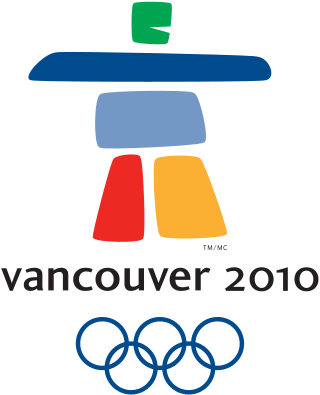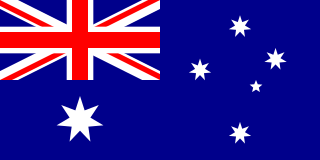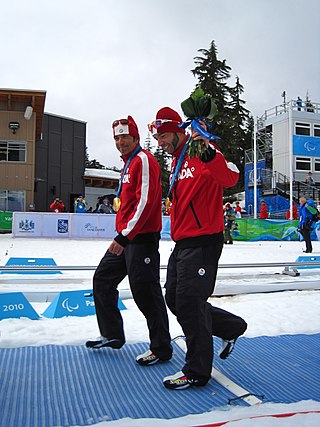Related Research Articles

The 2010 Winter Olympics, officially known as the XXI Olympic Winter Games and also known as Vancouver 2010, were an international winter multi-sport event held from February 12 to 28, 2010 in Vancouver, British Columbia, Canada, with some events held in the surrounding suburbs of Richmond, West Vancouver and the University of British Columbia, and in the nearby resort town of Whistler. It was regarded by the Olympic Committee to be among the most successful Olympic games in history, in both attendance and coverage. Approximately 2,600 athletes from 82 nations participated in 86 events in fifteen disciplines. Both the Winter Olympic and Paralympic Games were organized by the Vancouver Organizing Committee (VANOC), headed by John Furlong. The 2010 Winter Games were the third Olympics to be hosted by Canada, and the first to be held within the province of British Columbia. Canada had hosted the 1976 Summer Olympics in Montreal, Quebec, and the 1988 Winter Olympics in Calgary, Alberta.

The 1988 Winter Olympics, officially known as the XV Olympic Winter Games and commonly known as Calgary 1988, were a multi-sport event held from February 13 to 28, 1988, with Calgary, Alberta as the main host city. This marks the most recent time that two consecutive Olympic Games were hosted in North America. It was the first Winter Olympic Games to be held for 15 days, like the counterpart Summer Olympic Games. The majority of the events took place in Calgary itself. However, the snow events were shared by Nakiska ski resort in Kananaskis Country at the west of the city and the Canmore Nordic Centre Provincial Park in the town of Canmore.

The 1988 Winter Paralympic Games were the fourth Winter Paralympics, held again in Innsbruck, Austria. These were the last Paralympics to be held in a separate location from the Olympics. Beginning in 1992, the Olympics and the Paralympics were held in the same city or in an adjacent city. These Paralympics were not held at the same Olympic venue in Calgary, Canada, because of financial and recruiting difficulties. A total of 377 athletes from 22 countries took part. The USSR competed for the first and only time. Sit-skiing was introduced as another event in both the Alpine and Nordic skiing competitions. Other sports were biathlon and ice sledge speed racing. Ice sledge speed racer Knut Lundstroem from Norway was the most successful athlete, winning four gold medals in the 100m, 500m, 1000m and 1500m events.
The 1988 Winter Olympics, officially known as the XV Olympic Winter Games, was a winter multi-sport event held in Calgary, Canada, from 13 to 28 February 1988. A total of 1,423 athletes representing 57 National Olympic Committees (NOCs) participated in 46 events from 10 different sports and disciplines. Five new events were contested at these Games—men's and women's Super G in alpine skiing, team events in Nordic combined and ski jumping, and women's 5000 metres in speed skating—and two events returned to the program—men's and women's combined in alpine skiing.

Alpine skiing at the 1988 Winter Olympics consisted of ten alpine skiing events, held February 15–27 at Nakiska on Mount Allan, a new ski area west of Calgary.

Australia competed at the 1988 Winter Olympics in Calgary, Alberta, Canada. Eighteen athletes participated, competing in alpine skiing, biathlon, cross-country skiing, figure skating, and speed skating, and for the first time bobsleigh. Australia's best result was tenth by Danny Kah in the 5000 metres speed skating.
Biathlon at the 1988 Winter Olympics consisted of three biathlon events. They were held at the Canmore Nordic Centre, about 100 kilometres from the host city of Calgary. The events began on 20 February and ended on 26 February 1988.

Several tropical nations have participated in the Winter Olympics despite not having the climate for winter sports. Partly because of that, their entries are a subject of human interest stories during the Games. No tropical nation has ever won a Winter Olympic medal.

Guam sent a four-member delegation to the 1988 Winter Olympics in Calgary, Alberta, Canada from 13 to 28 February 1988. This is, as of 2022, Guam's only appearance in the Winter Olympic Games. The Guam delegation included only one athlete biathlete, Judd Bankert, who became Guam's first Olympic athlete. In his only event, the sprint, Bankert finished in 71st out of 72 competitors.

Guam has competed in eight Summer Games and one Winter Games. Guam first participated in the Olympics in the Winter Games in 1988 when Judd Bankert became Guam's first Olympic athlete competing in the biathlon. Only two athletes from Guam, canoeist Sean Pangelinan and judoka Ricardo Blas Jr, have made it past the first round of competition. During the 2008 Games in Beijing, Pangelinan advanced to the C-1 500m semi-finals and Blas Jr progressed to the Round of 16 100 kg+ Judo competition at London 2012.

Brian McKeever is a Canadian cross-country skier and biathlete, who became Canada's most decorated Winter Paralympian when he won his 14th medal at the 2018 Winter Paralympics. He finished the 2018 Games with a career total of 13 gold medals and 17 medals, making him the most decorated Paralympic cross-country skier ever. McKeever claimed a 16th Paralympic gold medal in the men's para cross-country middle distance vision impaired race at Beijing 2022, drawing him level with the German para-alpine racer Gerd Schönfelder for the most men's Winter Paralympic wins.
Michael Dixon, is a Scottish cross-country skier and biathlete. He has represented Great Britain at six Olympic Games in cross-country skiing and biathlon. He is only the seventh athlete from any country to have competed at six Winter Games and is one of fewer than fifty athletes to have competed in at least six Olympic Games.

Robin McKeever is a Canadian Paralympic cross-country skier.

For the 1988 Winter Olympics in Calgary, Alberta, Canada, a total of nine sports venues were used. Calgary tried twice to host the Winter Olympics in the 1960s without success before finally winning the 1988 Winter Games in 1981. Stampede Corral was built in 1950 while McMahon Stadium was built in 1960. When the National Hockey League (NHL) Flames franchise was relocated from Atlanta, Georgia in the United States during the summer of 1980, a new arena was needed. The Saddledome construction was underway in late 1981 when Calgary was awarded the 1988 Games. Completed in 1983, the Olympic Saddledome has played host to the Flames ever since, including three Stanley Cup Finals and the NHL All-Star Game in 1985. An innovation for the games was the first indoor long-track speed skating venue which has served as a model for future Olympics. The bobsleigh and luge track was the first combination track in North America and was noted for the Jamaican bobsleigh team crash during the four-man event. Both the Oval and the bobsleigh/luge track continue to host the World Championships in their respective sports since the 1988 Winter Olympics.
Felix Belczyk is a Canadian former alpine skier who competed in the 1988 Winter Olympics and 1992 Winter Olympics.
The men's 20 kilometre individual biathlon competition at the 1988 Winter Olympics was held on 20 February, at Canmore Nordic Centre. Each miss resulted in one minute being added to a competitor's skiing time.
The Men's 10 kilometre sprint biathlon competition at the 1988 Winter Olympics was held on 23 February, at Canmore Nordic Centre. Competitors raced over three loops of the skiing course, shooting two times, once prone and once standing. Each miss was penalized by requiring the competitor to race over a 150-metre penalty loop.
The men's 4 x 7.5 kilometre biathlon relay competition at the 1988 Winter Olympics 23 February, at Canmore Nordic Centre. Each national team consisted of four members, with each skiing 7.5 kilometres and shooting twice, once prone and once standing.
The Olympiques Calgary Olympics '88 (OCO'88), originally incorporated as XV Olympic Winter Games Organizing Committee was the organization responsible for overseeing the planning and development of the 1988 Winter Olympic Games.
References
- XV Olympic Winter Games Organizing Committee (1988). XV Olympic Winter Games : official report (PDF). Vol. 2. Calgary, Canada: Calgary Olympic Development Association. ISBN 0-921060-26-2. Archived from the original (PDF) on 2012-02-12. Retrieved 2010-02-20.
- 1 2 3 4 5 6 7 Lew Freedman (February 23, 1988). "Bloodied, but not last, guy from Guam is all smiles". Anchorage Daily News. p. 93. Retrieved 19 February 2010.[ permanent dead link ]
- ↑ "National Olympic Committees > Guam". Olympic.org. International Olympic Committee. Retrieved 19 February 2010.
- 1 2 United Press International (February 24, 1988). "Olympic notebook". Ellensburg Daily Record. Ellensburg, Washington. p. 7. Retrieved 19 February 2010.[ dead link ]
- ↑ Official report, p.632
- 1 2 "WWPL Offers Special Exhibits and Free Admission for Students on Presidents' Day". Woodrow Wilson Presidential Library. February 9, 2009. Retrieved 19 February 2010.[ dead link ]